Two comets spark excitement for the coming week — NEOWISE might reach naked-eye visibility at dawn, while Lemmon will be visible in binoculars at dusk.
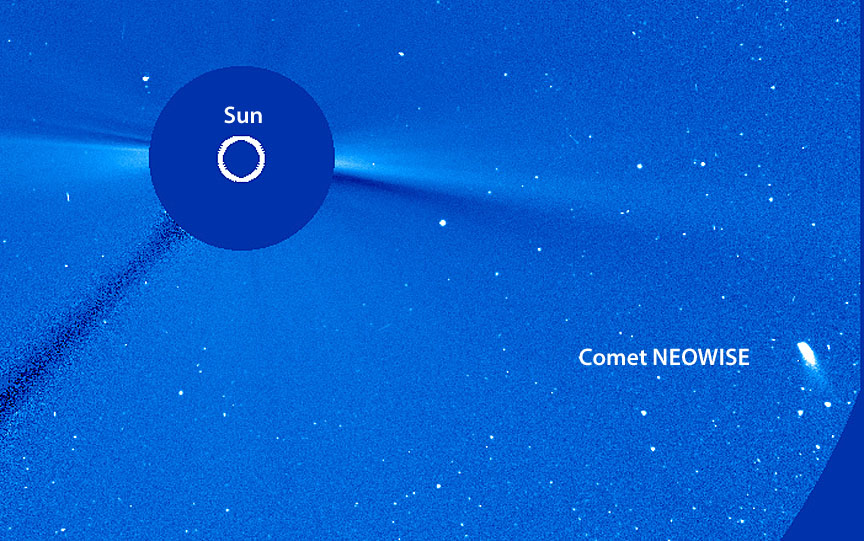
NASA / ESA
Dare we hope? Expectations were high for comets ATLAS (C/2019 Y4) and SWAN (C/2020 F8) last season but both ultimately fizzled. Will Comet NEOWISE (C/2020 F3) finally take us to the naked-eye finish line?
Comet NEOWISE (C/2020 F3) has a close brush with the Sun on July 3rd when it reaches perihelion at a distance of 44 million kilometers, some 14 million km closer on average than the planet Mercury. If it survives the solar onslaught skywatchers in the Northern Hemisphere could see it peep over the northeastern horizon at dawn glowing at first magnitude. Its unusual name comes from NASA's Near-Earth Object Wide-field Infrared Survey Explorer (NEOWISE), which discovered the comet back in March.
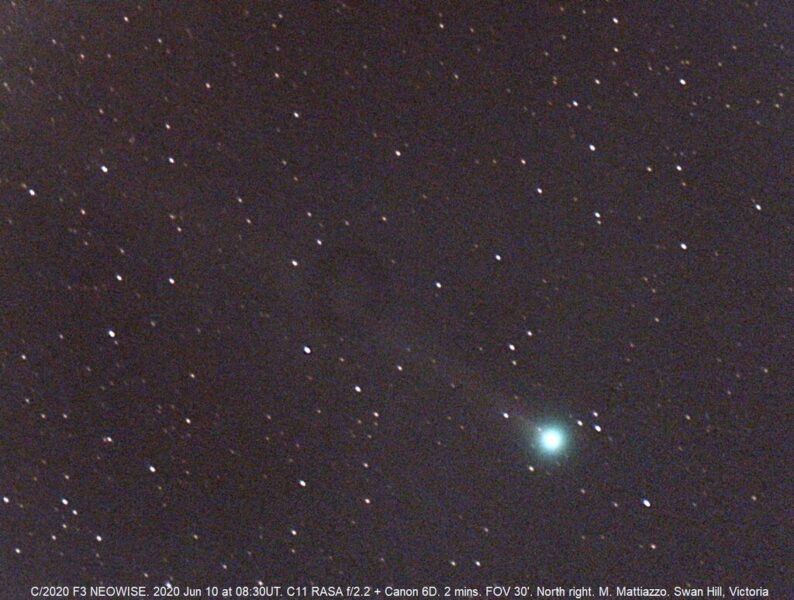
Michael Mattiazzo
By now we all know that comet magnitude predictions should be taken with a proverbial grain of cometary ice. But there's cause for optimism: When last photographed in the field of SOHO's C3 coronagraph NEOWISE appeared intact and was still climbing in brightness, both great signs. The most recent ephemeris from the Central Bureau for Astronomical Telegrams, dated June 27th, includes a cautious peak magnitude estimate of +0.6 on July 5th, followed by +0.8 on July 7th, the expected date of the comet's first appearance at dawn.
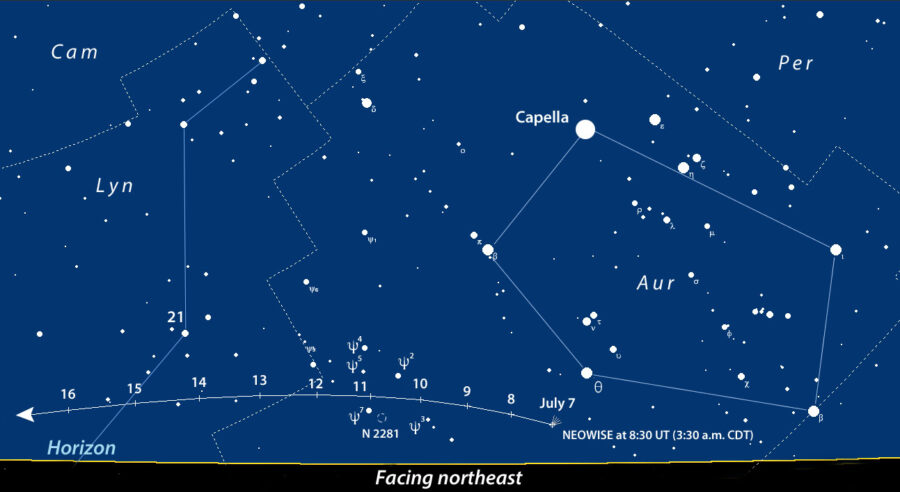
Created with Chris Marriott's SkyMap
First expectations
During its debut week NEOWISE will hug the northeastern horizon. From the southern states it will stand only about 2°–3° high at the start of morning twilight. The central and northern U.S. fair better with altitudes between 3° and 7°. The situation improves considerably once the comet emerges in the evening sky at mid-month.
If NEOWISE stood high in a dark sky at 1st magnitude it would be incredibly obvious even from the suburbs. But while shining at its brightest it hovers near the horizon through mid-July, so it will appear about two magnitudes fainter than the published estimates. Denser, dustier air near the horizon both scatters and absorbs light from celestial objects compared to overhead views, where we look through much less atmosphere.
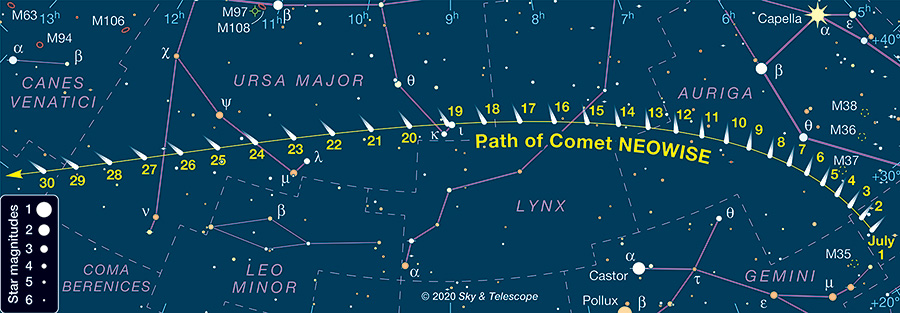
Sky & Telescope
Assuming NEOWISE will look about 3rd magnitude I encourage you to bring along a pair of binoculars or a small, wide-field telescope for a satisfying view. Comet heads can be bright while tails are often faint and wispy, making them difficult to see with the naked eye. I can't tell you how many times my 10×50 binoculars have revealed a beautiful feathery appendage that my unaided eye struggled to see. Based on the SOHO images, NEOWISE should be wagging a tail pointing upward from the northern horizon.
A splendid evening appearance
Bright moonlight will compromise the dawn view until about July 11th, which happens to be the same time that NEOWISE emerges into the evening sky. There, it quickly gains altitude while zipping across Ursa Major under moonless skies. Although the comet fades to magnitude 2 by mid-month and magnitude 3 by month's end, its increasing elevation will help offset its diminishing light, making the latter half of July the prime time to enjoy the comet.
For the best views of NEOWISE at both dawn and dusk find a location with a wide-open northern horizon such as a lake or field. More happy news: The comet's dawn and dusk appearances coincide with the best time for noctilucent cloud watching. Keep a lookout.
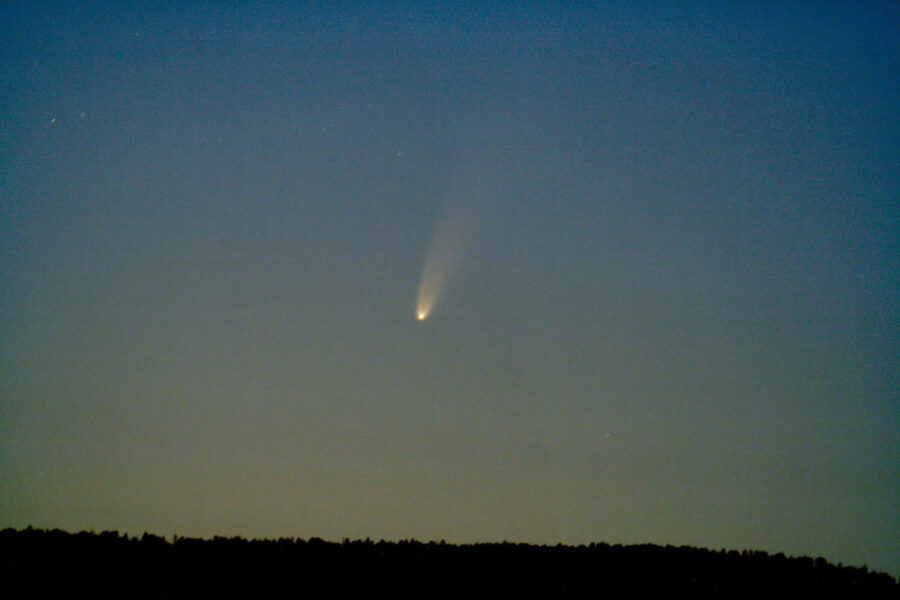
(Special note! Carl Hergenrother, ALPO Comet Section coordinator, managed to spot the comet in 30×125 binoculars shortly before sunrise in a rapidly brightening sky on July 1 around 11:45 UT from Arizona. He described it as "easy" in the large instrument and "difficult but visible" in a pair of 10×50s. NEOWISE was just 3.6° high at the time with a magnitude of ~1.0.)
Lemmon joins the scene
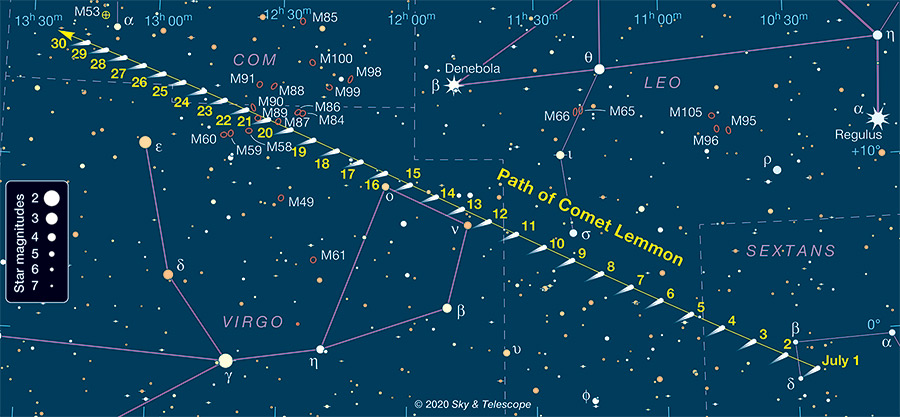
Sky & Telescope
If you're like me and burn the candle at both ends, be sure to set aside time in the evening for the arrival of Comet Lemmon (C/2019 U6). After a splendid run in the Southern Hemisphere, where it maxed out at 6th magnitude, it's now on its way north. Although the comet has dimmed to magnitude 7, it still sports a gorgeous tail and should be a lovely sight in binoculars and telescopes from a dark sky.
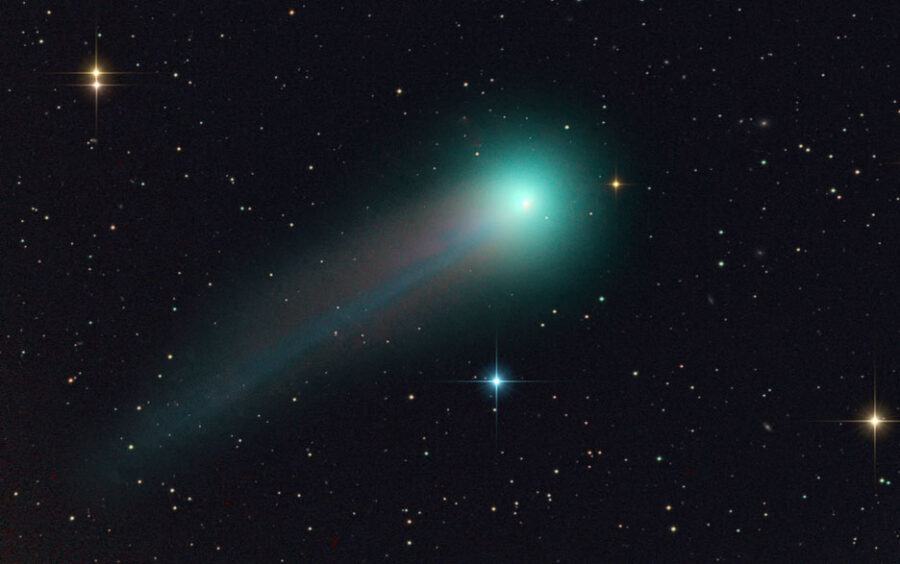
Rolando Ligustri
Lemmon makes its initial appearance low in the western sky around July 4th in Sextans and gradually ascends, crossing the rich Virgo Cluster of galaxies at mid-month before reaching Coma Berenices at month's end. The comet passed perihelion on June 18 and swung closest to Earth at 124 million km on June 29th. Like NEOWISE, it will slowly fade, dimming by about 1.5 magnitudes during July.
Southern special
Although Southern Hemisphere observers will miss the best days of NEOWISE, their consolation prize is Comet 2P/Encke, currently making a bright but low-altitude appearance as it jogs across Cancer at dusk. On June 30th, amateur Chris Wyatt estimated its magnitude at 7.3 and described the comet as a "bright, starlike pseudo-nucleus surrounded by a thin, hazy coma." This apparition will be a poor one for the Northern Hemisphere, with Encke only showing up in late August after fading to around magnitude 12. Click here for a finder map.
 34
34









Comments
Weixelman
July 1, 2020 at 4:51 pm
Bob - thanks for the update! Exciting news. Planning on trying to get a photo on the morning of July 6.
You must be logged in to post a comment.
Bob KingPost Author
July 1, 2020 at 11:22 pm
Hi Weixelman,
You're welcome! Good luck on your photo venture. If you do get an image, please send it here (send a link) so we can see.
You must be logged in to post a comment.
Zubenelgenubi 61
July 1, 2020 at 5:34 pm
Is there any information if there is any forward scattering present in the recent estimates? If there isn't too much, it would be a good sign. Another good sign, besides the comet being seen this morning, would be that it apparently has been here before, with a period of about 5,000 years- and it survived then. I notice that NEOWISE and LEMMON will only be about 10° apart in early August.
You must be logged in to post a comment.
Bob KingPost Author
July 1, 2020 at 11:23 pm
Hi Zuben,
I have not heard about how much forward scattering there might be currently. Yes, it helps that NEOWISE has been around before. A little pre-baking helps. Not only will NEOWISE and Lemmon be near one another but so will T2 PanSTARRS around that time.
You must be logged in to post a comment.
chergen
July 3, 2020 at 4:18 pm
Zuben and Bob,
Forward scattering is not contributing to NEOWISE's brightness. In fact its current phase angle of ~50 degrees is probably hurting its brightness. Maximum phase angle is 108 degrees on June 17. That may provide a boost of a few 0.1s of a magnitudes at that time.
You must be logged in to post a comment.
chergen
July 3, 2020 at 4:31 pm
I meant JULY 17 and not JUNE.
You must be logged in to post a comment.
Bob KingPost Author
July 3, 2020 at 8:30 pm
Chergen,
Thank you very much for your help in answering the question. I hope we'll see a modest bump in brightness (or a slight slowdown in fading) of the comet come mid-July.
You must be logged in to post a comment.
Tom-Reiland
July 4, 2020 at 6:58 am
I made a decision after midnight to drive up to Wagman Obs to try to locate Comet NEOWISE. I took my 10 X 50 binocs and my Jaegers 5" f/5 Refractor with 32 mm and 24.5 mm eyepieces. I used the 24.5 mm eyepiece, which produced 25.6 magnification. I thought about using the 20" Reflector and the 5" Jaegers attached to it, but when I opened the roof I noticed that there were trees blocking the region of the sky where the comet was located. I set up my 5" so that it was pointed at the gap in the trees where I estimated the comet could be observed. The sky conditions were not great because of the Moon, haze and humidity. I started hunting for NEOWISE at about 4:35 AM EDT and found it at 4:42 AM in the scope. It looked much like the images on some of the webpages. The nucleus/Coma was compact and I noticed a stubby tail about several minutes of arc in length. Ten minutes later I was able to spot it through my 10 X 50 binoculars. I estimated the tail at roughly 1/4 to 1/2 of a degree. I'm just guessing because of the haze and twilight sky, but I'll put the brightness at 1st magnitude, give or take a couple of tenths. It had to be at least 1st magnitude to be observed in those sky conditions. By 5:10 AM, I could no longer see the comet in the scope. I closed up the observatory and packed up my scope and gear. I got home about Sunrise. This is the 193 comet that I've observed, dating back to 1973 with Kohoutek.
You must be logged in to post a comment.
Bob KingPost Author
July 4, 2020 at 12:35 pm
Congrats, Tom! You're one of the first to observe its northern apparition. I was also out this morning (July 4.35 UT) with binoculars and my portable 10" f/4.5 scope. Very low and I had clouds / haze as well but the nuclear region was clearly yellow, and I spotted a faint short tail to the SW. Got a couple quick photos before clouds robbed it for good. Take a look at the new Chris Schur photo of the comet from this morning I'll be uploading to the article shortly. You'll be amazed.
You must be logged in to post a comment.
Tom-Reiland
July 4, 2020 at 2:24 pm
Thank you, Bob. I wouldn't have tried to observe it this early it if I hadn't read about Alan Hale's observation and saw some of the images online. I also noticed that the nucleus was yellow. I can't wait to see it in a dark sky.
You must be logged in to post a comment.
Bob KingPost Author
July 4, 2020 at 2:54 pm
Tom, I was going to wait, too but early photos revealed it was bright enough to go for. Glad I did. Hoping for tomorrow morning, too. Good luck to you and everyone else eager to see NEOWISE.
You must be logged in to post a comment.
misha17
July 7, 2020 at 7:37 pm
Another Mike here; I saw Neowise both in binoculars and naked eye standing on hill overlooking the Los Angeles basin. At that time of the morning, twilight light was far brighter than city lighting.
It helped that high pressure over the Western U.S. kept the usual summertime marine layer offshore, but when I got home after sunrise we were socked in by heavy fog.
You must be logged in to post a comment.
Bob KingPost Author
July 7, 2020 at 8:03 pm
Hi Misha,
Wow, that's got to be one of the ultimate tests of comet visibility. Thank you for sharing your view from the hill.
You must be logged in to post a comment.
Tom-Reiland
July 5, 2020 at 6:05 am
I arrived at Wagman Obs about 4:10 AM EDLT. Once again I was the Lone Astronomer. This time I used my 100 degree field of view, 20mm, Explore Scientific eyepiece with my 5" f/5 Jaegers Refractor. It produces 31.5X, as compared to the 25.6X that the other ocular gave me. I spotted NEOWISE at 4:42 AM, the same time as the previous morning. It was very similar in appearance, though it might have faded 0.1 to 0.2 magnitudes. It could have been caused of the hazy conditions with thin, patchy clouds near the NE horizon that might have produced the apparent dimming. The nucleus was still compact and yellow. The tail was longer, maybe between 0.5 to 1 degree. It looked nice in my 10 X 50 binoculars also. I started to pack up my gear at 5:15 AM and headed home.
You must be logged in to post a comment.
Tom-Reiland
July 4, 2020 at 8:16 pm
Bob, I forgot to thank you for the fine charts you added to your article. They were very helpful in my effort to find the comet.
You must be logged in to post a comment.
Rod
July 6, 2020 at 6:07 am
Bob King et al. Success! I had some fun early this morning from my Maryland horse farm location, comet NEOWISE in the binocular views
[Observed 0430 EDT - 0510 EDT/0830 UT - 0910 UT. I was able to see the comet using 10x50 binoculars this morning near the end of my pasture standing in my neighbor's large horse farm field. Distinct with bright nucleus and short tail. AT 0443 EDT I located the comet using my binoculars and viewed. Cirrus clouds, morning haze, and altocumulus clouds made for less than perfect seeing conditions. A cloud bank low in E-NE, NEOWISE elevation placed it above the cloud bank so visible in binoculars.
Theskylive.com site reports this morning apparent magnitude +2.0. Venus and Capella made locating the comet easy this morning.]
You must be logged in to post a comment.
Bob KingPost Author
July 6, 2020 at 9:12 pm
Woo-hoo, Rod! Very happy at your success. Thanks for sharing your observation as always.
You must be logged in to post a comment.
mary beth
July 7, 2020 at 1:02 am
Excellent! What a beautiful site!
You must be logged in to post a comment.
SNH
July 6, 2020 at 7:52 am
Great article, Bob! I had wondered if you would be writing about Lemmon since I was able to see it in 12x60 binoculars low in the west on the evening of June 24th. I haven't seen it since due to Saharan Dust, clouds, rain, etc.
I knew about NEOWISE last month, but it wasn't until I read your article late on July 4th and saw that amazing photo by Chris Schur that I got inspired to try for it! It has been almost exactly a month since I had big expectations for SWAN, which was following a very similar path across the sky, and had hopes to be one of the first people in North America to see it (and maybe the first to do so naked-eye). That one fizzled heavily in my opinion, even though I did eventually get to see it in binoculars.
So this morning, I started looking for it at 4:35am CDT. After finding Theta Aur in binoculars and seeing what I thought was a bright star below it, I used my 5" f/5 reflector to try and find that same bright star figuring the comet would be close by. Turns out, that was the comet!!! I immediately picked it up as an orange out-of-focus star with a dim fan coming off it.
I watched the comet from 4:40 to 5:30 as some clouds drifted over it from time to time. What I found was that NEOWISE was brighter than Theta Aur, which is +2.6. I was accompanied by my younger brother and both he and I were able to (barely) see the comet naked-eye with averted vision! Heck, I was able to detect it's tail naked-eye!! This is now my 42nd comet and probably the brightest one I've seen (magnitude wise, not visibility). The comet looked exactly like Chris Schur's photo in my 12x60 binoculars at about 4:55am.
So I'm really excited that this comet is making up for SWAN's disappointment. Crazy that this one got discovered in March and it has outdone so many this year!!
Scott Harrington
You must be logged in to post a comment.
Mike-Mackowski
July 6, 2020 at 3:20 pm
I got up early, drove a few miles away from the worst of the Phoenix suburban lights, and saw it easily, naked eye. I'd post the best photo but not sure how to do that here.
You must be logged in to post a comment.
Bob KingPost Author
July 6, 2020 at 9:08 pm
Hi Mike,
That's wonderful to hear especially so close to a large city. Thanks for sharing your report.
You must be logged in to post a comment.
Bob KingPost Author
July 6, 2020 at 9:11 pm
Fantastic report, Scott! Thanks for writing in. I have seen it once through clouds (July 4) but am anticipating a clear morning tomorrow. I think PanSTARRS in 2013 was the last bright comet with an obvious tail. That head of that one also appeared strikingly yellow in my scope.
You must be logged in to post a comment.
SNH
July 6, 2020 at 9:34 pm
Thanks, Bob.
I meant to say "...been almost exactly two months since I had big expectation for SWAN." And checking my notes again, this has been my 43rd comet - not 42nd.
Yes, up until this morning, the brightest comet I've seen was 3rd-magnitude C/2011 L4 PanSTARRS in 2013. And the similarities are eerie, though this has a longer and more narrow tail. But boy, when you find that the comet is as bright as the naked-eye guide stars to it, you know you've got a bright one. And I'll never get tired of seeing ones that show a tail in binoculars...which are extremely rare I've found!
You must be logged in to post a comment.
Ueli Waltert
July 7, 2020 at 5:05 am
Jungfrau means virgin and is the name of a mountain in Switzerland.
On https://jungfrau.roundshot.com/top-of-europe-jungfrau-ostgrat/
July 7, 2020 at 03:50 CET
you can see NEOWISE just right of a mountain.
You must be logged in to post a comment.
OwlEye
July 7, 2020 at 5:05 pm
Hi Bob,
I finally got a chance to observe and image comet NEOWISE this morning. In spite of thick smog and Saharan dust, I picked it out of the crud with a 7 x 50 binocular at 4:40 am local time from Lenexa, KS, when only 4.6 degrees above the horizon. What a gem!! The view in the 6-inch scope at 76 X was stunning! Wonderful detail in the inner tail and coma. Got a couple decent images, too.
More importantly: A WORD TO THE NEOWISE. Many of the images of this interloper on the internet show a bright comet standing out in stark contrast to a bright twilight sky. A lot of these are multiple comet image stacks combined with a single image of a nicely exposed twilight horizon. The average onlooker may think that if they go out tomorrow morning, they too will see a bright comet in a bright twilight sky. We know this is far from the truth (at least at this point in N's career!), and these arguably gorgeous pics are as misleading as they are beautiful. A single image of the comet and twilight sky does not produce images like these show-stoppers, but more like the ones I uploaded to Spaceweather earlier today. Even then, these images give a better idea of how the comet looked in the 7 x 50 binocular. I could not even see it naked eye due to all the smog and dust.
I cannot wait to see what this "long-haired star" has in store for us as it approaches its closest pass by the Earth on July 23rd.!!
You must be logged in to post a comment.
Bob KingPost Author
July 7, 2020 at 8:06 pm
Doug,
Absolutely excellent advice. I wrote a blog about seeing the comet this morning and cautioned naked-eye viewers encouraging people to bring binoculars or risk seeing only a faint presence.
You must be logged in to post a comment.
OwlEye
July 7, 2020 at 11:22 pm
Thank you, Bob.
In addition to the image stacked photos, time exposures that are taken just after the beginning of astronomical twilight will bring out the comet, and the resulting sky will look like the beginning of nautical twilight. Again, a beautiful, but quite misleading image as pertaining to the naked eye view. The resulting pic looks like it was taken just before sunrise!
We need more folks in the media that will do their best to help the public know just what to expect when they step out the door to see for themselves.
You must be logged in to post a comment.
cyrtonyx
July 8, 2020 at 11:11 am
Rose early this morning to view comet NEOWISE. Up at 0400 MDT and scanned the NE horizon, Nothing, Figured a bit too early so in the interim i views Mars, Saturn & Jupiter. Venus blazed like a beacon in the east. Locals have been reporting it as a UFO lately, after all this is New Mexico. At about 0420 I again scanned the NE horizon with 10x bins and saw NEOWISE rising. Beautiful! It reminded me of comet Bennet I viewed as a 9 year old around Easter 1970. I watched NEOWISE rise for another 20 minutes before the dawn started to wash it out, The waning moon made skies not completely dark, but the comet was visible to my unaided eyes with a noticable tail. What a treat!
You must be logged in to post a comment.
OwlEye
July 8, 2020 at 12:34 pm
Hi Bob,
If you have not seen it already, have a look at the still, B&W image by Michael Jaeger posted at 10.55 am for today in the Spaceweather NEOWISE gallery. There appears - along with the long ion tail - to be what looks like synchronic bands in the dust tail. If that is what they are (and not some artifact of the processing or clouds), NEOWISE's nucleus may be fragmenting (Comet West did this back in 1976). If so, we might be in for one wonderful show!
You must be logged in to post a comment.
Bob KingPost Author
July 8, 2020 at 7:26 pm
Well, well well, wouldn't that be nice. We will all be watching in case it happens. I studied the nucleus closely this morning (July 8) and did not detect any separate components.Thanks, Doug.
You must be logged in to post a comment.
Jim-Gasser
July 9, 2020 at 9:56 am
Wow! My first sighting from suburban Maumee OH near Toledo. Pointed the 7x50's and - BOOM - the first thing I saw! Then in the 20 x 80 binoculars, the view was a thrill! Definitely could see the bifurcated effect in the tail. My estimate of brightness was 2.0 based on star comparisions, but I'm not good at that - one must take into account stellar point source vs a diffuse comet head & tail, etc. Reminded me of Comet Bennett, although I started looking at 5:00 am EDT when dawn was fairly bright (about 1:09 before sunrise). I could definitely see it by naked eye an hour before sunrise, although you had to know where to look. I suspect earlier, it would have been easy. I couldn't take my eyes off of it in binos and followed it until about half hour before dawn.
Bob- thanks for your excellent reporting. I too am walking on air with light shooting from my fingertips! Setting the alarm for 4:00 am tomorrow!
You must be logged in to post a comment.
Bob KingPost Author
July 9, 2020 at 5:06 pm
Wahoo, Jim! Just reading your report gets me excited all over again for my next attempt tomorrow morning. Thanks for writing!
You must be logged in to post a comment.
debarup
July 14, 2020 at 6:17 am
Sir, Can you please tell me which is the best low cost telescope to watch Neowise comet?
My budget is $100 - $200
Thanks in advance
Debarup
You must be logged in to post a comment.
Bob KingPost Author
July 14, 2020 at 9:58 am
Hi Debarup,
For that price range I can recommend the Orion Starblast 4.5-inch telescope: https://www.amazon.com/Orion-10015-StarBlast-Reflector-Telescope/dp/B00D12U1IK
You must be logged in to post a comment.
You must be logged in to post a comment.